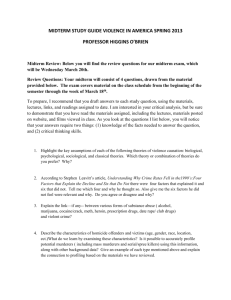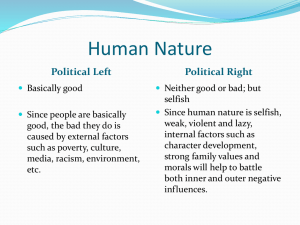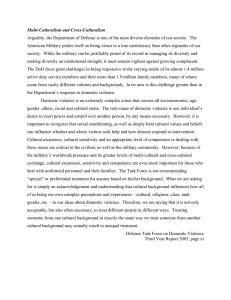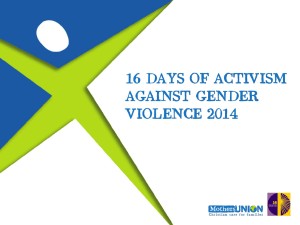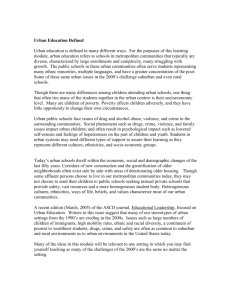Crime Mapping News Inside this Issue Volume 5 Issue 3 Summer 2003
advertisement
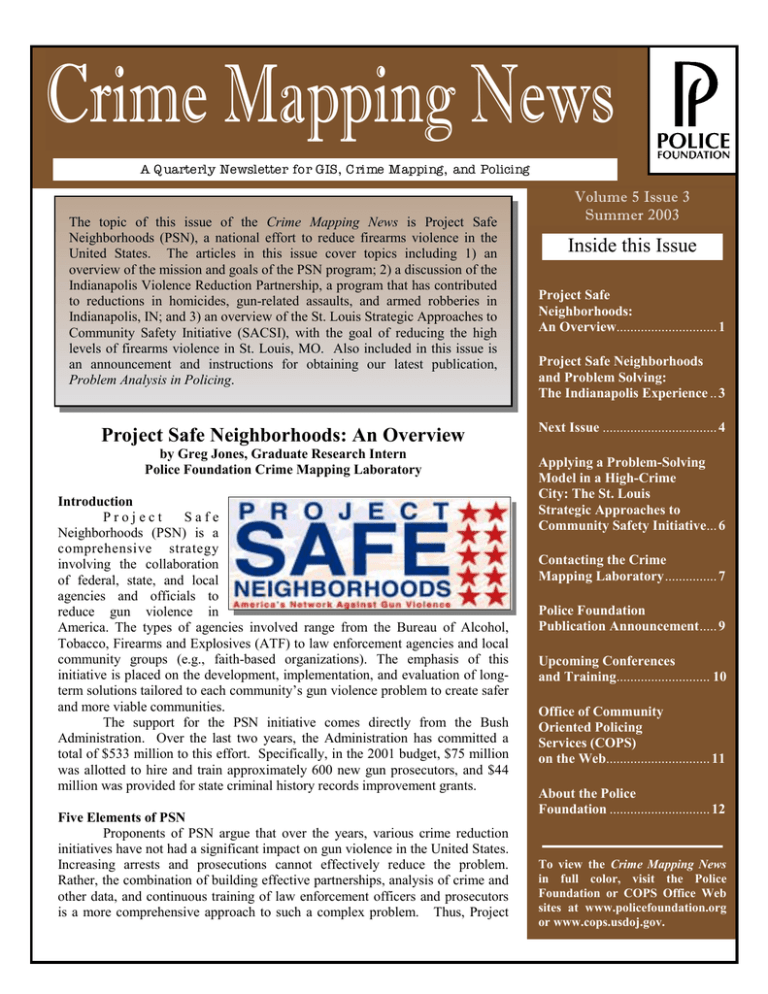
Crime Mapping News A Q uarterly Newsletter for GIS, C ri me Mapping, and Policing The topic of this issue of the Crime Mapping News is Project Safe Neighborhoods (PSN), a national effort to reduce firearms violence in the United States. The articles in this issue cover topics including 1) an overview of the mission and goals of the PSN program; 2) a discussion of the Indianapolis Violence Reduction Partnership, a program that has contributed to reductions in homicides, gun-related assaults, and armed robberies in Indianapolis, IN; and 3) an overview of the St. Louis Strategic Approaches to Community Safety Initiative (SACSI), with the goal of reducing the high levels of firearms violence in St. Louis, MO. Also included in this issue is an announcement and instructions for obtaining our latest publication, Problem Analysis in Policing. Project Safe Neighborhoods: An Overview by Greg Jones, Graduate Research Intern Police Foundation Crime Mapping Laboratory Introduction Project Safe Neighborhoods (PSN) is a comprehensive strategy involving the collaboration of federal, state, and local agencies and officials to reduce gun violence in America. The types of agencies involved range from the Bureau of Alcohol, Tobacco, Firearms and Explosives (ATF) to law enforcement agencies and local community groups (e.g., faith-based organizations). The emphasis of this initiative is placed on the development, implementation, and evaluation of longterm solutions tailored to each community’s gun violence problem to create safer and more viable communities. The support for the PSN initiative comes directly from the Bush Administration. Over the last two years, the Administration has committed a total of $533 million to this effort. Specifically, in the 2001 budget, $75 million was allotted to hire and train approximately 600 new gun prosecutors, and $44 million was provided for state criminal history records improvement grants. Five Elements of PSN Proponents of PSN argue that over the years, various crime reduction initiatives have not had a significant impact on gun violence in the United States. Increasing arrests and prosecutions cannot effectively reduce the problem. Rather, the combination of building effective partnerships, analysis of crime and other data, and continuous training of law enforcement officers and prosecutors is a more comprehensive approach to such a complex problem. Thus, Project Volume 5 Issue 3 Summer 2003 Inside this Issue Project Safe Neighborhoods: An Overview............................. 1 Project Safe Neighborhoods and Problem Solving: The Indianapolis Experience .. 3 Next Issue ................................. 4 Applying a Problem-Solving Model in a High-Crime City: The St. Louis Strategic Approaches to Community Safety Initiative... 6 Contacting the Crime Mapping Laboratory ............... 7 Police Foundation Publication Announcement ..... 9 Upcoming Conferences and Training........................... 10 Office of Community Oriented Policing Services (COPS) on the Web.............................. 11 About the Police Foundation ............................. 12 To view the Crime Mapping News in full color, visit the Police Foundation or COPS Office Web sites at www.policefoundation.org or www.cops.usdoj.gov. 2 C rime Mapping News Summer 2003 Safe Neighborhoods is composed of five elements that entail the participation of several key agencies: “Much of the emphasis of this national project is placed on the development, implementation, and evaluation of longterm solutions to create safer communities where residents can thrive.” ! Partnerships: This element requires that every United States Attorney coordinate gun-related partnerships at the federal, state, and local level. ! Strategic Plan: Each United States Attorney incorporates three national priorities into the unique strategic plan for their district: 1. Increased prosecution of violent organizations using federal conspiracy and all other available laws, 2. Heightened enforcement of all federal laws against illegal gun traffickers, and 3. Renewed aggressive enforcement of federal firearm laws against those persons prohibited from possessing firearms or those who use them in furtherance of illegal activities. ! ! ! Training: Specialized training is provided for federal, state, and local law enforcement officers and prosecutors to maintain an edge and keep them up-to-date on current laws and trends that affect law enforcement. The regional cross-training involves collaboration between the ATF, the National District Attorneys Association, and local law enforcement. Other training includes the International Association of Chiefs of Police Gun Interdiction Technical Assistance Project and the Police Executive Research Forum firearms training for state and local law enforcement. Outreach: This element involves a partnership between PSN and the National Crime Prevention Council (NCPC) to prepare a national outreach campaign to make criminals and citizens aware of this new approach to gun violence. The outreach materials include TV commercials, educational literature, and brochures, which are all part of the PSN Communication Tool Kit designed specifically for the local initiative in that district. Accountability: To assess the effectiveness of gun violence reduction plans, each United States Attorney, with the assistance of a research team, reports bi-annually to the Attorney General of the United States on four general areas: 1. The nature of the partnerships with federal, state, and local agencies and officials, and the community, 2. The nature and prevalence of gun crime and violence in the community, the reduction strategies adopted, and how the impact of those strategies is measured, 3. How the local gun crime reduction initiative is being publicized, and 4. Whether the partnership has taken advantage of training opportunities and/or has conducted training at the local level. These reports are reviewed by experts in each of the five PSN elements who provide feedback, identify model programs, and assist those who are experiencing implementation problems. Summary These five elements, the participation of key agencies, and direct support from the Bush Administration combine to form a united front committed to curbing gun violence in the United States. Much of the emphasis of this national project is placed on the development, implementation, and evaluation of long-term solutions to create safer communities where residents can thrive. Some partnerships within Project Safe Neighborhoods continue to build upon previous successful responses to gun violence, such as the Operation Ceasefire Project in Boston, MA, the Indianapolis Violence Reduction Partnership (discussed on pp. 3-5 of this newsletter), and Project Exile in Richmond, VA. The information for this article was taken from the Project Safe Neighborhoods Web site (www.psn.gov) and from Professor Edmund McGarrell’s article beginning on page 3 of this newsletter. Greg Jones is a Graduate Research Intern in the Police Foundation’s Crime Mapping Laboratory. He can be contacted via telephone at 202-833-1460. C rime Mapping News Summer 2003 Project Safe Neighborhoods and Problem Solving: The Indianapolis Experience by Edmund F. McGarrell Director and Professor of the School of Criminal Justice, Michigan State University Project Safe Neighborhoods (PSN) is a major federal initiative intended to reduce firearms violence in communities across the United States. PSN is being implemented by task forces that are coordinated by the 93 United States Attorneys across the country. In the Southern District of Indiana, PSN builds on a successful violence reduction initiative that has been operating in Indianapolis since January 1998. The Indianapolis program, known as the Indianapolis Violence Reduction Partnership (IVRP), was part of the Department of Justice’s (DOJ) Strategic Approaches to Community Safety Initiative (SACSI). SACSI was implemented in ten cities and called for applying a strategic problemsolving process to reduce violence in each community. IVRP is an incident review action team. The action team reviews all recent firearms violence incidents to uncover patterns and associations that may suggest points of intervention. The action team has evolved over time (e.g., from meeting every other week to meeting once per month) but has clearly been most effective when able to get knowledgeable street-level officers (police, probation and parole, prosecutors, gang and narcotics officers) in the same room discussing specific incidents, locations, group affiliations, and similar patterns. Two other key groups within the IVRP are a policymaker group consisting of the agency heads of all the participating agencies and a communications subcommittee. Multi-Agency Collaboration The problem-solving approach in Indianapolis has been based on a multi-agency partnership involving all the local, state, and federal criminal justice agencies serving the Indianapolis area; community partners including the faith community, Weed and Seed, neighborhood leaders and service providers, a media/ outreach partner; and a research team from the Hudson Institute and Indiana University. A working group that included representatives from all the participating agencies i mp l e me n t e d the IVRP and began meeting in January 1998 for a two-hour meeting every other week since that time. The working group employs a problemsolving process involving ongoing problem analysis that leads to both immediate responses to violence on the streets as well as a focus on longer-term policy and system issues. An additional key element of the Problem Analysis At the time that the IVRP was implemented, Indianapolis was experiencing a significant homicide and firearms violence problem. Indeed, from 1994 through 1997, the city experienced record-setting levels of homicide. A variety of analytic techniques were used and have continued to be used to assess the violence problem. This included trend analysis of UCR offenses known and calls for service, crime mapping, analysis of criminal histories of homicide victims and suspects, 3 4 C rime Mapping News Summer 2003 crime gun tracing, analysis of probation and parole Impact records, and group reviews of homicides and firearms Assessing the impact of a citywide, multicrime incidents. component intervention like SACSI and PSN is The picture that emerged was similar to that extremely complex. Thus, the positive findings that witnessed in many urban cities. Firearms violence emerge from Indianapolis should be considered with predominantly involved young men in particular this qualification in mind. The IVRP interventions were geographic areas of the city. Homicide victims and initiated in late 1998 and early 1999 with full suspects tend to look much like one another and have implementation occurring with the arrest and federal e x t e n s i ve pr i o r prosecution of a gang criminal histories. heavily involved in Much of the firearms “With the implementation of PSN, the IVRP violence and drug violence in distribution in the (Indianapolis Violence Reduction Partnership) has spring of 1999. Indianapolis also had a renewed infusion of resources and enthusiasm. Analysis of the involved some connection to illegal The additional firearms prosecutors have led to a trend in violence drug sales, and many ndicated an doubling of federal prosecutions for firearms iapproximate of the participants in 40% offenses.” violence were also reduction in known to be part of h o mi c i d e , gu n groups of chronic assaults, and armed offenders. These groups included fairly well-organized robberies when comparing an approximate two-year gangs as well as neighborhood crews or cliques of period pre- and post-April 1999. Additional evidence offenders. came from interviews with recently arrested individuals who reported an increase in the perceived likelihood of arrest, prosecution, and incarceration for firearms Strategic Interventions Based on this analysis, the IVRP developed a violence. Finally, homicides following the intervention strategic plan that is made actionable in the bi-weekly were less likely to involve firearms, victims and working group meetings. The overall strategy adopted was one that combined focused deterrence with a commitment to linking potential offenders to legitimate opportunities and services. Essentially, the working group recognized that it could not address all the shortcomings of the criminal justice system but that it could increase the likelihood of sanctions for the illegal The next issue of the Crime Mapping News will possession and use of firearms. It also recognized that include a summary and discussion of the results of the deterrence message needed to be communicated in the Crime Mapping Laboratory’s training course, as many ways as possible to those most at risk of being Advanced Problem Analysis, Crime Analysis, & involved in violence. At the same time, there was a Crime Mapping, which was held from April 22nd commitment to linking these potential offenders and through May 1st, 2003, as well as descriptions of all victims to legitimate opportunities. the publications and products that have been Some of the key vehicles for putting the strategy developed during the Crime Mapping Laboratory’s in place were offender notification meetings, probationsix-year partnership with the Office of Community parole-police home visits to high risk probationers and Oriented Policing Services (COPS). parolees, warrant service to high risk offenders, directed police patrol, faith-based and social service outreach to If you are interested in contributing to a future issue potential offenders, joint local-federal firearms unit of the Crime Mapping News, please contact the screening of all firearms cases, and the development of a Crime Mapping Laboratory at: list of the most chronic violent offenders based on prior involvement in violence. The strategies primarily (202) 833-1460 included suppression and intervention approaches while building connections to more prevention-oriented approaches existing in the community. NEXT ISSUE C rime Mapping News Summer 2003 suspects described as part of a group of chronic offenders, and drugs. Homicides also became less geographically concentrated. Although these post-intervention shifts were not dramatic, taken collectively, they suggested that the dimensions of violence that were the focus of the interventions seem to have been affected. PSN With the implementation of PSN, the IVRP has had a renewed infusion of resources and enthusiasm. The additional firearms prosecutors have led to a doubling of federal prosecutions for firearms offenses. A new street enforcement unit involving local law enforcement and agents from the Bureau of Alcohol, Tobacco, Firearms and Explosives (ATF) has been implemented. A secure Web-based technology system has been developed that allows continual distribution of information about recent violence incidents among working group members and other criminal justice officials. Finally, PSN also provides the resources for a sustained media and public outreach campaign. Summary Early on in the experience of the IVRP, several experienced criminal justice officials lamented, “Oh no, not one more task force.” Today, those same individuals are some of the strongest proponents of PSN. They, along with 25-30 other busy professionals, including police officers, prosecutors, probation officers, federal agents, and city officials, continue to meet every other week as they have for nearly six years. One of the key reasons for this level of commitment is the problem-solving approach. The linkage of analysis and action is seen as providing a focus to the meetings, and more importantly, action between meetings has distinguished IVRP and PSN from so many task forces that lack the discipline provided by commitment to the problem-solving model. Indianapolis officials are hopeful that commitment to problem solving will lead to further reductions in firearms violence and ultimately lead to a reduction in both gunshot victims as well as the number of young men committing such offenses. Edmund F. McGarrell is Director and Professor of the School of Criminal Justice at Michigan State University. From 1998 - 2001, he served as the research partner of the IVRP. He is now the Principal Investigator (along with Timothy Bynum) of Michigan State’s project to provide research-based training, technical assistance, and research to Project Safe Neighborhoods. He can be contacted via e-mail at Edmund.McGarrell@ssc.msu.edu. Note from the Editors: The opinions expressed in the articles of this newsletter are those of the authors and do not necessarily reflect the views of the Police Foundation or the COPS Office. In addition, only light editing has been made to the articles in order to keep each author’s voice and tone. 5 6 C rime Mapping News Summer 2003 Applying a Problem-Solving Model in a High-Crime City: The St. Louis Strategic Approaches to Community Safety Initiative by Scott H. Decker, PhD, Shannan M. Catalano, MA, and G. David Curry, PhD Department of Criminology and Criminal Justice, University of Missouri - St. Louis Scanning and Analysis Introduction The late 1980s and early 1990s were periods of The Boston Ceasefire Project receives high rates of youth violence, a significant fraction of considerable attention from police practitioners and the which involved the use of a firearm. This pattern was research community. The Boston intervention used a true for the city of St. Louis as well as the nation. problem-solving model to analyze the dimensions of the Levels of youth firearm violence in St. Louis youth firearm violence problem in Boston and crafted have been well above those for the United States. For interventions based on the results of that analysis. The the years 1991 to 1993, the city’s homicide rate ranked intervention was also characterized by a large number of it among the top three of large cities, with a homicide partnerships. These partnerships existed within law rate of nearly 70 per enforcement groups 100,000 residents (police, prosecutors, “The late 1980s and early 1990s were periods recorded in 1991, while probation officers), across jurisdictional of high rates of youth violence, a significant the US rate was closer to per 100,000. The boundaries (federal, fraction of which involved the use of a 8increase in homicide was state, and local), and with firearm. This pattern was true for the city of most pronounced among community groups those under 18 years of (particularly the St. Louis as well as the nation.” age and those aged 18 to ministerial group known 24, with the number of as the Ten Point homicide victims in 1990 to 1992 twice that of 1980 to Coalition). The result of this intervention was a 1982 and the number of homicide suspects in that age sustained reduction of substantial proportions in the group tripling for the latter period. Firearms were youth firearm violence problem in Boston. disproportionately involved in homicides involving Despite the apparent successes in Boston, some people under age 24, as guns were responsible for concern existed that methods such as those employed in causing death in more than 90% of these cases. Boston were less likely to work in cities characterized Mirroring national patterns, young black males, by very high levels of youth homicide. After all, despite especially those aged 15 to 24, were the most likely the increases in violence, the Boston homicide rate had victims of homicide in St. Louis. In 1990 to 1992, never ranked among the highest cities. In addition, homicide rates for black males 15 to 19 exceeded 380 because Boston dominates the Metropolitan Statistical per 100,000, and those for black males aged 20 to 24 Area (MSA) in terms of population, cooperation reached 600 per 100,000. For these groups, firearms between criminal justice groups in Boston was higher accounted for virtually all deaths—99% of the younger than might be the case in MSAs where the central city is age group and 97% of the older group. a much smaller proportion of the overall population. St. Louis is a particularly appropriate site for The Strategic Approaches to Community Safety research on and interventions to stem criminal violence, Initiative (SACSI) was part of the National Institute of in part because of its extremely high rates of homicide. Justice’s response to the high rates of violence Nearly all of the increase in homicides since the late experienced in many large American cities from the late 1980s was accounted for by the increase in gun 1980s to the mid 1990s. St. Louis was included as part homicides, and this increase, in turn, is concentrated in of the second group of five cities that participated in the the younger age groups. During the early 1990s, the SACSI process, beginning in October 2000. St. Louis homicide rate for black males between the ages of 15 was joined by Detroit, MI; Atlanta, GA; Albuquerque, and 19 was more than 5 times higher than the record NM; and Rochester, NY among the 2000 SACSI cities. rate for the city as a whole. The rate for 20 to 24 yearEach of these cities had homicide rates that exceeded old black males was almost twice that of the younger those of Boston; Detroit, Atlanta, and St. Louis age group—an astounding 626 per 100,000. St. Louis is consistently rank among the top ten cities in the country an appropriate site for such interventions for another in terms of homicide rates per 100,000 population. C rime Mapping News reason. The correspondence between US and St. Louis homicide rates over the thirty-year period from 1960 to 1990 is remarkably strong. When converted to standard scores, the correlation between the two data series is nearly .95, suggesting that interventions that change local patterns may have national relevance. Additionally, there is a strong spatial concentration of indicators of violence, particularly the distribution of homicides, firearm recoveries, and shots fired calls to the 911 (CAD) system. The distribution of these indicators of violence in the city has historically been located within several distinct hotspots of violence. Twelve of the city’s 79 neighborhoods account for roughly half of the homicides. In addition, individuals involved in homicide—whether as victims or offenders—had extensive criminal histories. Ninety percent of suspects and 79% of victims had a prior felony criminal history, and roughly one-quarter of each group was serving a term of probation or parole. Data from the Trauma Department of the Level I Trauma Center indicated that a large proportion of shooting victims (perhaps as high as one-third) have been treated for gunshot wounds in the past, and many gunshot wound victims do not appear in police records. Interventions The key findings that the working group took from these analyses to help shape the interventions Summer 2003 included the strong spatial concentration of violence, the involvement of homicide victims and offenders in prior offending, and the key role of the Trauma Department at the Level I Trauma Center in responding to violence. Members of the SACSI working group developed three key interventions. These included: (1) the Most Violent Offenders program, now known as the Worst of the Worst (WOW); (2) the Fifth District Initiative; and (3) the Trauma Intervention Project (TIP). WOW is based on the premise and data which suggest that a small fraction of offenders are engaged in a large volume of offending and that by pursuing these individuals with vertical prosecution, vigorous summons and warrant enforcement, and attention from multiple law enforcement groups (federal and local as well as gang, drug, and tactical units within the police department), a reduction in crime could be achieved. A number of criteria have been developed for inclusion on the list, key among them is being wanted for a homicide or Armed Criminal Action, as well as having a warrant refused for such offenses. The goal of WOW is to take high-rate offenders off the street, and in doing so, to curb retaliatory violence. The Fifth District Initiative has been the most important of the three initiatives. The Fifth District incorporates just over 4 square miles and roughly 28,000 residents. Despite its small geographic and population size, the district recorded 20 homicides in the CONTACTING THE POLICE FOUNDATION CRIME MAPPING LABORATORY: By Phone: By Fax: By E-mail: By Mail: (202) 833-1460 (202) 659-9149 rboba@policefoundation.org 1201 Connecticut Avenue, NW Suite 200 Washington, DC 20036 Also, feel free to contact individual Crime Mapping Laboratory staff with questions or comments. Rachel Boba, PhD, Director Mary Velasco, Research Associate Greg Jones, Graduate Research Intern 7 8 C rime Mapping News Summer 2003 year 2000 and 25 in the year 2001, a two-year average of 82 homicides per 100,000—nearly double the citylevel average and 11 times greater than the US average. The analysis of homicides found considerable gang involvement in homicide, both on the part of victims and perpetrators, and high numbers of multiple victim and multiple suspect homicides. As a consequence, both the Gang Unit and the Tactical Unit spent considerable time in the Fifth District everyday. In addition, the undercover drug unit and detectives from the Central Patrol Area invested more time in this District. The US Attorney and the Circuit Attorney (state-level prosecutor) paid special attention to gun cases that came from this District. The goal of the Fifth District Initiative is to provide visible suppression of criminal conduct, rapid prosecution, and support to a beleaguered community. While not conclusive evidence, homicides in the Fifth District fell to 17 in 2002, and as of April 10, 2003, no homicides have been recorded in the Fifth District. In addition, serious assaults have declined in the College Hill neighborhood (the center of the initiative) from 3.16 violent incidents per month for the six months prior to the intervention to 1.21 violent incidents per month in the 13 months since the intervention was initiated. The Trauma Intervention Project is perhaps the most compelling and tenuous of the initiatives. This initiative was tenuous because of the newly formed partnership between medical and law enforcement personnel. TIP included cross-training police and trauma personnel, improving the chain of evidence for bullets and other possessions, better communication between trauma and police personnel, in-house counseling with victims of violence (VOV), and followup from the Emergency Department to the neighborhoods to monitor and counsel victims of violence. In addition, more police attention was proposed for the “hangers-on” in and around the Emergency Room whose friends were being attended to by medical personnel. While a protocol for training was developed, and certain chain of custody issues were resolved, the departure of the Trauma Leader in August 2002 had severe negative consequences for the program, and it essentially lays dormant at this time. Conclusions The St. Louis experience with SACSI has demonstrated that even in a city with high levels of violence and limited experience in problem solving across agencies, this process can be integrated effectively. The intervention has also achieved success in contributing to declines in assaultive violence in a targeted area. The key to these successes has been leadership within the St. Louis Metropolitan Police Department and the US Attorney’s Office. What has been more difficult to achieve, however, has been sustained partnerships between law enforcement agencies and other groups. This is hardly a novel finding for St. Louis or other locations (Decker and Curry, 2003), but does illustrate the difficulty of forging and sustaining new partnerships. Of considerable importance in St. Louis has been the development of new, unanticipated products of the initiative. One promising product has been the biweekly meeting between an Assistant US Attorney; a state level prosecutor; two representatives of the Bureau of Alcohol, Tobacco, Firearms and Explosives; and the St. Louis Metropolitan Police Department. This group reviews every arrest in which a gun was involved to determine the appropriate venue for prosecution (federal or state) based on the strength of the case, penalties available in each system, and other considerations. The SACSI process is consistent with the Project Safe Neighborhoods (PSN) approach, and the experience with SACSI has enabled St. Louis to make a smooth and effective transition toward achieving the goals of PSN. Reference Decker, Scott H. and G. David Curry. (2003). “Suppression Without Intervention, Intervention Without Suppression: Gang Intervention in St. Louis.” Pp. 189-213, in S. Decker (Editor), Policing Gangs and Youth Violence. Belmont, CA: Wadsworth. Scott H. Decker, PhD, is a Curators Professor in the Department of Criminology and Criminal Justice at the University of Missouri-St. Louis and can be contacted via e-mail at deckers@msx.umsl.edu. Shannan M. Catalano, MA, is a PhD student in the Department of Criminology and Criminal Justice at the University of Missouri-St. Louis and can be contacted via e-mail at catalanos@msx.umsl.edu. G. David Curry is a Professor in the Department of Criminology and Criminal Justice at the University of Missouri-St. Louis and can be contacted via e-mail at dave_curry@umsl.edu. C rime Mapping News Summer 2003 PUBLICATION ANNOUNCEMENT The Police Foundation’s Crime Mapping Laboratory would like to announce the release of its latest report, PROBLEM ANALYSIS IN POLICING authored by Rachel Boba, PhD, Director of the Crime Mapping Laboratory. This is the full report from which the Executive Summary was published in the Crime Mapping News as Volume 5, Issue 1, Winter 2003. The aims of this report are to introduce and define problem analysis and to provide guidance on how problem analysis can be integrated and institutionalized into modern policing practices. The report is not a “how to” guide on conducting problem analysis, but is a summary of ideas and recommendations about what problem analysis is, what skills and knowledge are necessary to conduct it, and how it can be advanced by the police community, academia, the federal government, and other institutions. Electronic copies of the report can be obtained on the Police Foundation or COPS Office Web sites at: www.policefoundation.org or www.cops.usdoj.gov Hard copies of the report can be obtained by submitting an order form, available on the Police Foundation’s Web site at www.policefoundation.org/pdf/problemanalysisorderform.pdf. Instructions for submitting the order via mail, fax, or e-mail are provided on the form. ...the basic premise in problem-oriented policing is that the acquisition of knowledge informs practice. - Herman Goldstein 9 10 C rime Mapping News Summer 2003 Upcoming Conferences and Training August Rio Hondo Public Safety Training Center: ArcView Training August 11-15, 2003 Whittier, CA Contact: Bob Feliciano, bfeliciano@riohondo.edu or (562) 692-0921 Crime Mapping & Analysis Program (CMAP): ArcView Training August 18-22, 2003 Denver, CO Contact: Danelle Digiosio, ddigiosi@du.edu or (800) 416-8086 September California Crime and Intelligence Analysts Association (CCIAA) Annual Conference September 4-5, 2003 San Diego, CA www.crimeanalyst.org Fourth Annual Western Pennsylvania GIS Conference September 5, 2003 Canonsburgh, PA www.cup.edu/liberalarts/earthscience/gis Crime Mapping & Analysis Program (CMAP): ArcView Training September 8-12, 2003 Northeast Counterdrug Training Center, PA Contact: Danelle Digiosio, ddigiosi@du.edu or (800) 416-8086 International Association of Law Enforcement Planners (IALEP) Annual Conference September 28-October 3, 2003 Colorado Springs, CO www.ialep.org General Web Resources for Training Seminars and Conferences http://msdis.missouri.edu www.actnowinc.org www.alphagroupcenter.com www.cicp.org www.cops.usdoj.gov www.esri.com/events www.ialeia.org www.ialep.org www.mapinfo.com/events www.nlectc.org/nlectcrm www.nijpcs.org/upcoming.htm www.nsgic.org www.ojp.usdoj.gov/nij/maps www.urisa.org/meetings.htm Early Reminders! International Association of Crime Analysts (IACA) Annual Conference October 27-30, 2003 Kansas City, MO www.iaca.net Florida Crime and Intelligence Analyst Association (FCIAA) Training Conference November 12-14, 2003 Ponte Vedra Beach, FL www.fciaa.org Seventh Annual International Mapping and Analysis for Public Safety (MAPS) Conference March 31-April 3, 2004 Boston, MA www.ojp.usdoj.gov/nij/maps C rime Mapping News Summer 2003 11 ABOUT THE POLICE FOUNDATION The Police Foundation is a private, independent, not-for-profit organization dedicated to supporting innovation and improvement in policing through its research, technical assistance, and communications programs. Established in 1970, the foundation has conducted seminal research in police behavior, policy, and procedure, and works to transfer to local agencies the best new information about practices for dealing effectively with a range of important police operational and administrative concerns. Motivating all of the foundation’s efforts is the goal of efficient, humane policing that operates within the framework of democratic principles and the highest ideals of the nation. OFFICE OF RESEARCH BOARD OF DIRECTORS Chairman William G. Milliken D. Kim Rossmo, PhD Director of Research Rachel Boba, PhD Director, Crime Mapping Laboratory President Hubert Williams David Weisburd, PhD Senior Fellow David Cole Mary Velasco, MS Research Associate Wade Henderson Vanessa Ruvalcaba, BA Research Assistant William H. Hudnut III Greg Jones, MA Graduate Research Intern W. Walter Menninger Tamika McDowell, BA Senior Administrative Assistant Laurie O. Robinson Henry Ruth Weldon J. Rougeau Alfred A. Slocum Maria Vizcarrondo-DeSoto Kathryn J. Whitmire 1201 Connecticut Avenue, NW, Suite 200, Washington, DC 20036 (202) 833-1460 " Fax (202) 659-9149 " e-mail: pfinfo@policefoundation.org www.policefoundation.org This project was supported by cooperative agreement #2002-CK-WX-0303 awarded by the Office of Community Oriented Policing Services, US Department of Justice. Points of view or opinions contained in this document are those of the authors and do not necessarily represent the official position or policies of the US Department of Justice.

